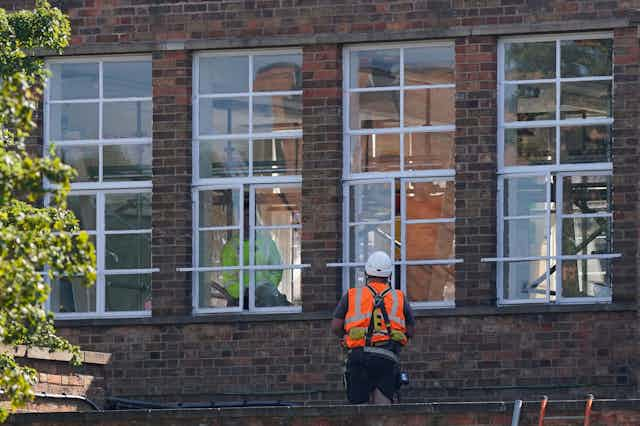Physical spaces make a difference to education. There are small but fairly reliable correlations between the quality of the buildings where students learn and student behaviour, attendance and academic achievement.
In particular, inadequate buildings are linked to poorer outcomes: pupils learning in crumbling classrooms do worse. Students are negatively affected when limited or inappropriate space hinders teaching or learning.
Pupils at schools with Raac, who are now packed into temporary classrooms for subjects like science, or who have lost the use of their library, will be currently experiencing such obstructions to their education.
This relationship between where pupils learn and how well they learn should be a central part of decisions about building, or repairing, schools. And what may seem strange is that this relationship was at the centre of the post-war designs carried out using Raac. The crisis comes not as a result of the decisions made when these schools were built, but from subsequent decades of neglect and changing policy.
The light-build school designs that led to the use of Raac were not the result of mindless penny-pinching. They were the product of a determination to spread the benefits of secondary education across the population after the second world war by building quickly and relatively cheaply.
The resulting buildings had short lifespans, but were intended to be refurbished or replaced as necessary. This way, they could be responsive to new educational needs and ideas in ways that the more substantial brick buildings of the 19th and early 20th century were not.
Patchy upkeep
That such renewal did not happen is obvious to anyone educated in postwar buildings during the 1980s and 1990s. New schools were rare and maintenance was poor. This changed after 2000 – but changes in government and resulting policy change stymied the effectiveness of school building programmes.
Labour established the Building Schools for the Future (BSF) programme, which ran from 2003 to 2010. This saw school buildings as an opportunity for change in education. Government documents talked of “transformation” and favoured tailored, individual design solutions, focusing on a vaguely defined future rather than current circumstances. There was also an intention to address inequality by prioritising areas of higher deprivation.

The Conservative-Liberal Democrat coalition government elected in 2010 moved fast to stop BSF. The reasons given included the potential inefficiency of more individual school designs, a lack of clarity about educational “transformation” and a fundamental disagreement with funding not centred on the physical state of the building.
Instead, the government set up the Priority School Building Programme (PSBP) which ran until 2021. This time, decisions were to be made objectively on the basis of physical need, with new buildings and maintenance as the data dictated. New schools were intended as a functional response to current needs, rather then for an unknown future. In place of individual tailoring and encouragement for innovation, PSBP provided standardisation and “baseline designs” for schools.
However, the number of planned school repairs was cut. Missing the need to replace Raac systematically further suggests that this programme failed on its own terms.
No consistency
My own research, which followed an English school through a PSBP rebuild, showed that teachers liked the traditional design of enclosed classrooms along corridors, as it suits the style of splitting learning into individual subjects that the English exam system rewards.
Of course, these buildings will not work so well if there are curriculum innovations or pedagogical change – and here lies the problem with 21st-century school building in England.
The sorts of political twists and turns that have occurred make it much more difficult to pursue a coherent strategy to make school space work for learning. Policy in other countries has been much more consistent – and innovative.
Australia has followed through on its Building the Educational Revolution programme, with continued investment in flexible designs. Iceland has spent the last two decades progressively developing designs to personalise learning and enable collaboration between teachers.
By contrast, in England there has been an inability to learn steadily from experience in relation to school buildings but also in education more generally. This is in danger of undermining the efforts of teachers and students. It certainly discourages any sense that it’s worth investing effort in new ways of doing things.

